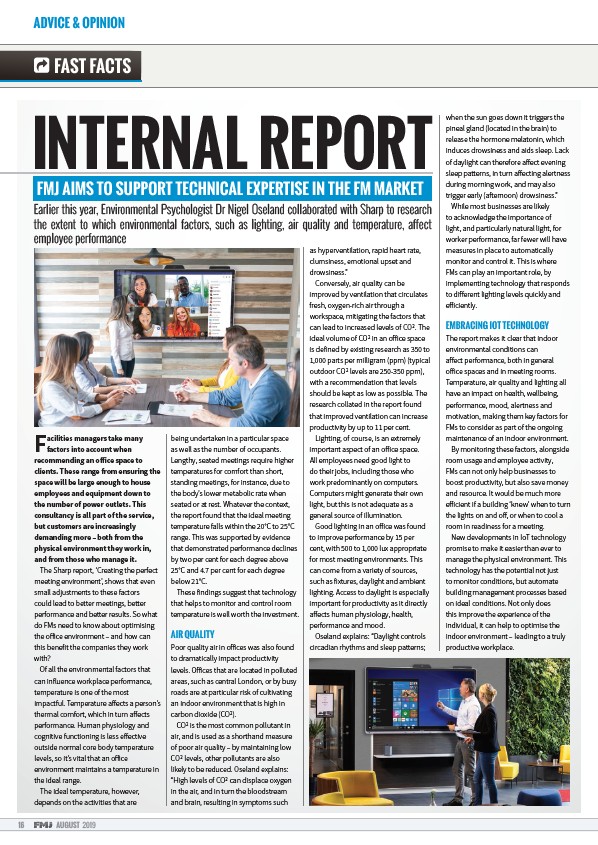
ADVICE & OPINION
INTERNAL REPORT
FMJ AIMS TO SUPPORT TECHNICAL EXPERTISE IN THE FM MARKET
Earlier this year, Environmental Psychologist Dr Nigel Oseland collaborated with Sharp to research
the extent to which environmental factors, such as lighting, air Tuality and temperature, aff ect
employee performance
Facilities managers take many
factors into account when
recommending an o ice space to
clients. These range from ensuring the
space will be large enough to house
employees and equipment down to
the number of power outlets. This
consultancy is all part of the service,
but customers are increasingly
demanding more – both from the
physical environment they work in,
and from those who manage it.
The Sharp report, ‘Creating the perfect
meeting environment’, shows that even
small adjustments to these factors
could lead to better meetings, better
performance and better results. So what
do FMs need to know about optimising
the o ice environment – and how can
this benefit the companies they work
with?
Of all the environmental factors that
can influence workplace performance,
temperature is one of the most
impactful. Temperature a ects a person’s
thermal comfort, which in turn a ects
performance. Human physiology and
cognitive functioning is less e ective
outside normal core body temperature
levels, so it’s vital that an o ice
environment maintains a temperature in
the ideal range.
The ideal temperature, however,
depends on the activities that are
16 AUGUST 2019
being undertaken in a particular space
as well as the number of occupants.
Lengthy, seated meetings require higher
temperatures for comfort than short,
standing meetings, for instance, due to
the body’s lower metabolic rate when
seated or at rest. Whatever the context,
the report found that the ideal meeting
temperature falls within the 20°C to 25°C
range. This was supported by evidence
that demonstrated performance declines
by two per cent for each degree above
25°C and 4.7 per cent for each degree
below 21°C.
These findings suggest that technology
that helps to monitor and control room
temperature is well worth the investment.
AIR QUALITY
Poor quality air in o ices was also found
to dramatically impact productivity
levels. O ices that are located in polluted
areas, such as central London, or by busy
roads are at particular risk of cultivating
an indoor environment that is high in
carbon dioxide (COŽ).
COŽ is the most common pollutant in
air, and is used as a shorthand measure
of poor air quality – by maintaining low
COŽ levels, other pollutants are also
likely to be reduced. Oseland explains:
“High levels of COŽ can displace oxygen
in the air, and in turn the bloodstream
and brain, resulting in symptoms such
as hyperventilation, rapid heart rate,
clumsiness, emotional upset and
drowsiness.”
Conversely, air quality can be
improved by ventilation that circulates
fresh, oxygen-rich air through a
workspace, mitigating the factors that
can lead to increased levels of COŽ. The
ideal volume of COŽ in an o ice space
is defined by existing research as 350 to
1,000 parts per milligram (ppm) (typical
outdoor COŽ levels are 250-350 ppm),
with a recommendation that levels
should be kept as low as possible. The
research collated in the report found
that improved ventilation can increase
productivity by up to 11 per cent.
Lighting, of course, is an extremely
important aspect of an o ice space.
All employees need good light to
do their jobs, including those who
work predominantly on computers.
Computers might generate their own
light, but this is not adequate as a
general source of illumination.
Good lighting in an o ice was found
to improve performance by 15 per
cent, with 500 to 1,000 lux appropriate
for most meeting environments. This
can come from a variety of sources,
such as fixtures, daylight and ambient
lighting. Access to daylight is especially
important for productivity as it directly
a ects human physiology, health,
performance and mood.
Oseland explains: “Daylight controls
circadian rhythms and sleep patterns;
when the sun goes down it triggers the
pineal gland (located in the brain) to
release the hormone melatonin, which
induces drowsiness and aids sleep. Lack
of daylight can therefore a ect evening
sleep patterns, in turn a ecting alertness
during morning work, and may also
trigger early (a› ernoon) drowsiness.”
While most businesses are likely
to acknowledge the importance of
light, and particularly natural light, for
worker performance, far fewer will have
measures in place to automatically
monitor and control it. This is where
FMs can play an important role, by
implementing technology that responds
to di erent lighting levels quickly and
e iciently.
EMBRACING IOT TECHNOLOGY
The report makes it clear that indoor
environmental conditions can
a ect performance, both in general
o ice spaces and in meeting rooms.
Temperature, air quality and lighting all
have an impact on health, wellbeing,
performance, mood, alertness and
motivation, making them key factors for
FMs to consider as part of the ongoing
maintenance of an indoor environment.
By monitoring these factors, alongside
room usage and employee activity,
FMs can not only help businesses to
boost productivity, but also save money
and resource. It would be much more
e icient if a building ‘knew’ when to turn
the lights on and o , or when to cool a
room in readiness for a meeting.
New developments in IoT technology
promise to make it easier than ever to
manage the physical environment. This
technology has the potential not just
to monitor conditions, but automate
building management processes based
on ideal conditions. Not only does
this improve the experience of the
individual, it can help to optimise the
indoor environment – leading to a truly
productive workplace.
FAST FACTS